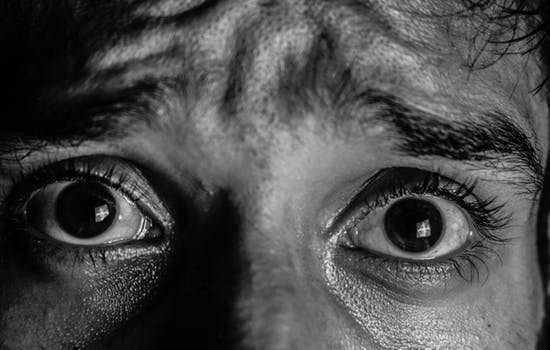In a 2017 national survey, it was reported that 6.4% of people ages 26 and older had done methamphetamine.
Meth can go by many names – crystal, crank, speed, tweak, chalk – and it often depends on what form it takes.
There are also various different methods for taking methamphetamine. It can be snorted, injected, smoked, or swallowed.
But one thing is for sure: no matter what it’s called or how it’s taken, meth is a dangerous and addictive substance.
If you suspect that someone you know might be under the influence of meth, keep an eye out for these common signs of meth use.
Dilated Pupils
The appearance of a person’s eyes can be a very telling factor when you think they might be partaking in drug abuse.
There are several different kinds of drugs that affect a person’s eyes. Alcohol can make eyes bloodshot; marijuana can make eyes droopy.
But amphetamines are known for dilating pupils. Drugs like cocaine, MDMA, and yes, meth, can increase a person’s pupils to an unnatural size.
But it’s important that you consider other side effects like the ones below, because certain prescription drugs may also affect the eyes.
Mood Swings
One of the main reasons that meth users get addicted is because of the euphoric rush that they get from the drug.
However, once that rush is gone, users might start to experience symptoms of withdrawal. Meth withdrawal can make them irritable or even angry, causing them to partake in violent behavior.
Long term meth abuse may lead to frequent mood swings or even depression because of the brain’s inability to produce certain chemicals (like dopamine) on its own.
Decreased Appetite
Amphetamines/stimulants are often used in place of diets in order to lose a lot of weight quickly (although it should go without saying that this is extremely dangerous and is never recommended).
The so-called “cocaine diet” is one popular example because of how it suppresses appetite and hinders the body’s ability to store fat.
Meth acts in a similar way. Meth abuse may lead to a decreased appetite and even drastic weight loss.
Inconsistent Sleeping Patterns
Since meth is a stimulant, it keeps users awake. Meth users have been known to stay away for several days at a time if they are using frequently.
Once the binge is over, users may be so exhausted that they sleep for just as long.
Nausea/Vomiting
Abuse of many types of drugs can induce nausea or vomiting, and meth is no exception.
In some cases, the drug may not sit well with the user which can cause these types of side effects. In other cases, nausea/vomiting could stem from other meth-related health issues.
Poor Dental Health
One of the most infamous side-effects of meth addiction is “meth mouth.”
When a person uses meth, especially for an extended period of time, it can lead to serious dental problems. This is thought to be caused by general neglect, clenching of the teeth, and the acidity of the drug, among other things.
These problems include broken, rotting, and stained teeth, as well as erosion of the gums, so they are usually quite noticeable.
Skin Conditions
Meth can cause itchy skin; in more severe cases, it can also cause hallucinations that simply make users feel like they have very itchy skin.
Incessant picking and scratching lead to sores. Then, because meth suppresses the immune system, these sores heal at a much slower pace.
Increased Sex Drive
Meth users often experience an increase in libido. This means that they have a stronger desire to engage in sexual activity.
This side effect can be dangerous in and of itself because an intense sex drive, combined with lowered inhibitions, can lead people to unsafe sexual encounters.
If someone is not being mindful when it comes to sex, they could be exposing themselves to sexually transmitted diseases.
Hyperthermia
A common symptom of meth use is hyperthermia, which increases your body temperature. A methamphetamine user might be noticeably sweaty or hot to the touch.
If someone is doing a lot of meth, the body temperature may rise so much that it becomes unsafe. Extreme hyperthermia can lead to unconsciousness or even death.
Increased Breathing Rate
Because meth is a stimulant, users may seem overly excited and/or talkative. You may notice increased physical activity for a period of time.
The activity and excitability combined with the effects of meth itself lead to an increased breathing rate.
Additionally, users can experience shortness of breath and a high heart rate. So, be aware of these behavioral signs to pinpoint potential substance abuse.
Twitching/Convulsions
While a meth addict is high, he/she may experience twitching. This can come in many different forms, from eye twitches to a strange gait.
If a person experiences a meth overdose, they might start to have convulsions/seizures. If you witness this, be sure to get medical help immediately.
Delusions
Meth addicts can show signs of mental side-effects as well as physical ones. Often, users will seem confused or paranoid. They may not always make sense.
Sometimes, whether from the drug or from lack of sleep, users will experience hallucinations.
Social Withdrawal
Usually, meth addicts will begin to seem less and less like themselves.
They often withdraw from healthy relationships for many reasons. They may have lost interest in their former lives, or they may fear judgment from friends and family.
Be on the Lookout for These Common Signs of Meth Use
Meth use is a serious, life-threatening problem.
Symptoms depend on each individual meth user, but these are some of the most common. If you notice several of these signs in someone you know, consider getting help for their meth addiction.
We at Northbound Treatment Center understand drug addiction and we’re here to assist with addiction treatment.. Don’t go through this alone. Contact us today to begin your journey to recovery.











